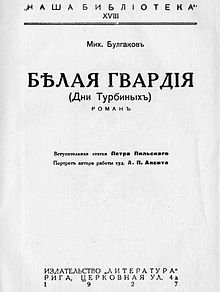|
The White Guard
The White Guard (Russian: Белая гвардия) is a novel by Mikhail Bulgakov, first published in 1925 in the literary journal Rossiya. It was not reprinted in the Soviet Union until 1966. BackgroundThe White Guard first appeared in serial form in the Soviet-era literary journal Rossiya in 1925,[1] but the journal was closed down before the serial was completed. The complete book was published in Paris in 1927. A censored version was published in the Soviet Union in 1966. The complete version was published in 1989. After the first two parts of The White Guard had been published in Rossiya, Bulgakov was invited to write a version for the stage. He called the play The Days of the Turbins. It was produced at the Moscow Art Theatre, to great acclaim. According to some sources, Stalin saw it no fewer than 20 times.[1] In fact, the play completely overshadowed the book, which was in any event virtually unobtainable in any form. PlotSet in Ukraine from late 1918, the novel concerns the fate of the Turbin family as the various armies of the Ukrainian War of Independence (the White Army, the Red Army, the Imperial German Army and Ukrainian nationalists) fight over the city of Kiev. Historical figures such as Pyotr Wrangel, Symon Petliura and Hetman Pavlo Skoropadsky appear as the Turbin family is caught up in the turbulent effects of the October Revolution. The novel's characters belong to the sphere of Ukrainian and Russian intellectuals and officers in the army of Skoropadsky and participate in defending the city from the Ukrainian nationalist forces, led by Petliura, in December 1918. The character Mikhail Shpolyansky is modelled on Viktor Shklovsky.[2] The novel contains many autobiographical elements. Bulgakov gave the younger Turbin brother some of the characteristics of his own younger brother. The description of the house of the Turbins is that of the house of the Bulgakov family in Kyiv. (It is now preserved and operated as the Mikhail Bulgakov Museum.) Characters
English translationsBulgakov's widow had The White Guard published in large part in the literary journal Moskva in 1966, at the end of the Khrushchev era. It was the basis for the English translation by Michael Glenny, first published in 1971, which lacks the dream flashback sections. In 2008, Yale University Press published a translation by Marian Schwartz of the complete novel, an edition that won an award.
Adaptations
References
External linksWikimedia Commons has media related to The White Guard.
|
||||||||||||||||||
